How To Remove Potting Material From A Pc Board
- #ane
I got a bad volume knob (potentiometer) on this PCB board. To supervene upon the pot, I need to remove the board from the metal plate which is sealed with resin silicone potting compound as shown in the pictures.
I put one time WD40 and Acetone on the black colored chemical compound with no success. Also, rut could damage the PCB lath and the parts on information technology.
What is the easiest and safest way to remove the PCB board from the metal plate?
Thank you
Attachments
-
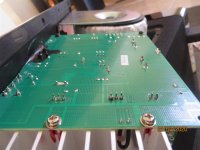
IMG_3110.JPG
117.1 KB · Views: 235
-
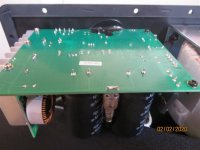
IMG_3109.JPG
98.five KB · Views: 261
-
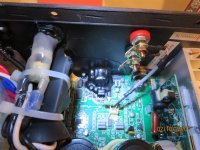
IMG_3292.JPG
159.2 KB · Views: 285
-
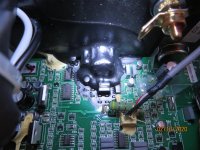
IMG_3294.JPG
161.5 KB · Views: 240
-
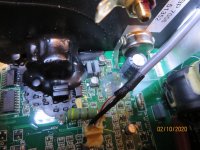
IMG_3307.JPG
140.iv KB · Views: 240
- #2
I got a bad book knob (potentiometer) on this PCB board. To replace the pot, I demand to remove the board from the metal plate which is sealed with resin silicone potting compound equally shown in the pictures.
I put once WD40 and Acetone on the blackness colored compound with no success. Also, rut could damage the PCB lath and the parts on it.
What is the easiest and safest way to remove the PCB board from the metal plate?
Thanks
there is no easy style, effort mechanical means, chemical wont work
- #3
there is no easy fashion, attempt mechanical means, chemical wont work
What kind of mechanical means?
- #4
milling, scraping, cutting, ripping, fingernails, cutting tools….silicone is soft and comparable weak and so employ your imagination
Final edited:
- #v
If it is 18-carat silicone rubber, then silicone digester will piece of work, only you ought non to need it, as silicone rubbers don't stick to anything, which is why they are used in mould making.
If information technology is really a prophylactic similar polyurethane, then it ought to be very well bonded to the components as polyurethanes are very ambitious in that department prior to its curing. You lot may find its glass temperature is likely below 85'c, so heat will arrive flexible and that will exist a way in.
kind regards
Marek
![]()
- #vi
See if you can get hold of dental tools. They are very tough and thus useful for peeling away potting, silicones etc. I likewise utilize them for cleaning flux off effectually large solder points.
![]()
- #7
I've depotted boards before by carefully heating with a hot air gun and slowly chipping away the glassed chemical compound. It can be time consuming simply it is possible.
![]()
Pano
Administrator
Paid Fellow member
- #8
 Thread moved.
Thread moved.
![]()
- #9
Trichloroethelene is a dangerous carcinogenic solvent used in the plastics industry only also dissolves nearly plastic resins. I have used information technology to reverse engineer potted assemblies.
Merely it does dissolve everything given enough fourth dimension, DIP IC'south, pcbs, coating on resistors etc etc. And plastic plumbing pipes. So if you can detect it, take care with fumes, vesture gloves and glasses and set on small bits a one fourth dimension with a cotton wool bud or similar.
- #10
I've used Trichloroethelene in a previous job.
Even if you tin detect someone that will sell you a small amount.
Don't use it.
It is one of the nastiest chemicals I take used.
If it contacts the skin it will feel like that area has been assault fire within seconds.
We used proper thick coated chemical gloves and even they were destroyed inside a calendar week.
Your best pick is every bit others have said, mechanical removal.
![]()
- #xi
Trichloroethelene (aka 'Tri') is indeed nasty, but used every bit a diluting agent for Tippex (no involvements), the infamous white blundercoverfluid. Sold in a combo.
The other variantion, more than often used in industrial environments (cough) is called tetrachloroethelene (yeah: 'Tetra'). Instead of three it has 4 chlorine atoms to dissolve its environs.
The silicone resin hulk looks awful depressing...
- #12
We used information technology for removal of conformal coating on circuit boards.
Nosotros were using 'safe-t-sol' until it was banned as a carcinogen.
Shame because information technology was fantastic.
Removed all traces of coating without hurting annihilation on the boards.
And so nosotros shifted to i.1.1. (Trichloroethelene).
What a hurting.
Again a carcinogen, stings the pare like hell, boards left in this stuff for to long could be written off from 'collateral' harm, evaporated extremely fast, and worst of all, even subsequently an extended bath, the boards notwithstanding needed mechanical scrubbing so nosotros could do a full resolder of the surface mounted ic's.
Fun fact, some available chemicals in Australia may accept been banned by other countries years or decades earlier.
And so if your looking at using any chemical in Au, check to run into if other countries take banned it.
- #thirteen
I have used naptha to break down and remove silicone adhesive/sealant, might be worth a endeavor.
Be sure and allow plenty of time to allow it to evaporate earlier whatsoever soldering nevertheless.
- #xiv
I have used thrichoroethylene as a best mechanical degreaser and on some plastic every bit
a mucilage.
Until it was banned.
I never had any health effect, merely because I take care reasonably.
Of course those who sniff information technology can take trouble.
The troubles have been grossly exaggerated.
So, now we are stuck with products three times more expensive and 3 times less efficient.
I can but recommend to use information technology, if yous can discover some.
Source: https://www.diyaudio.com/community/threads/how-to-remove-resin-silicone-potting-compound-on-pcb-boards.350155/

0 Response to "How To Remove Potting Material From A Pc Board"
Post a Comment